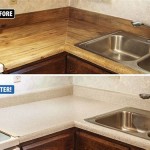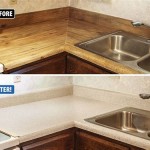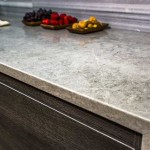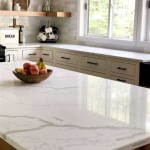Can I Paint My Bathroom Countertop? A Detailed Guide
The bathroom countertop, a functional and often overlooked element, can significantly impact the overall aesthetic of a bathroom. Over time, countertops can become worn, stained, or simply outdated. Replacing a countertop can be a costly and disruptive undertaking. Painting a bathroom countertop presents an alternative, more budget-friendly approach to revitalization. However, the feasibility and longevity of a painted countertop depend heavily on careful preparation, the selection of appropriate materials, and a clear understanding of the process's limitations.
Painting a bathroom countertop is not merely applying a coat of color. It requires meticulous adherence to a specific process to achieve a durable and visually appealing surface. Ignoring the necessary steps can result in a finish that is prone to chipping, peeling, or staining, ultimately leading to a waste of time and resources. Therefore, a comprehensive evaluation of the existing countertop material, the desired aesthetic outcome, and the commitment to proper preparation are crucial before embarking on this project.
Assessing Countertop Material
The suitability of a countertop for painting is directly linked to its original material. Different materials possess varying degrees of porosity, adhesion capabilities, and resistance to moisture, all of which influence the success of a paint application. Understanding the countertop's composition is the first step in determining whether painting is a viable option.
Laminate countertops, characterized by a thin layer of decorative plastic bonded to a substrate, are generally considered suitable for painting. Laminate surfaces are typically non-porous, requiring a primer designed to promote adhesion. The smooth surface of laminate allows for a relatively even paint application, contributing to a more professional finish. However, it's essential to thoroughly clean and degloss the laminate before priming to ensure proper bonding.
Ceramic tile countertops, composed of individual tiles joined by grout, present a more complex challenge. The grout lines create an uneven surface, which can be difficult to paint evenly. Furthermore, grout is porous and susceptible to staining, potentially affecting the overall appearance of the painted surface. While painting tile countertops is possible, it requires careful attention to detail, including thorough cleaning, priming, and sealing to protect the grout and achieve a uniform finish.
Solid surface countertops, such as Corian or similar acrylic-based materials, offer a relatively smooth and non-porous surface that is generally well-suited for painting. These materials are durable and resistant to moisture, making them a favorable candidate for bathroom countertop painting. Proper surface preparation, including cleaning and sanding, is still necessary to ensure optimal paint adhesion.
Natural stone countertops, such as granite or marble, are generally not recommended for painting. These materials are porous and require specialized sealants to prevent staining and water damage. Painting natural stone can compromise its natural beauty and potentially damage the stone itself. Furthermore, paint adhesion to sealed stone surfaces can be problematic, leading to peeling and chipping over time. Professional refinishing or sealing is typically a better option for maintaining the appearance of natural stone countertops.
Wood countertops, while aesthetically pleasing, are highly susceptible to water damage and require meticulous sealing and maintenance. Painting a wood countertop in a bathroom can be risky due to the constant exposure to moisture. If painting is considered, it is crucial to use a high-quality, water-resistant primer and paint specifically designed for wood surfaces. Regular sealing is essential to prevent water penetration and damage to the underlying wood.
Surface Preparation: The Key to Success
Regardless of the countertop material, proper surface preparation is the most critical factor in achieving a durable and aesthetically pleasing painted finish. Inadequate preparation can lead to paint failure, resulting in peeling, chipping, and staining. The surface must be thoroughly cleaned, deglossed, and primed before applying any paint.
The first step in surface preparation is a thorough cleaning. Use a strong degreasing cleaner to remove any dirt, grease, soap scum, or other contaminants from the countertop surface. Rinse the surface thoroughly with clean water and allow it to dry completely. This step is crucial for ensuring proper paint adhesion.
Deglossing the surface is essential for promoting paint adhesion, particularly on smooth, non-porous materials like laminate or solid surface countertops. Use a fine-grit sandpaper (e.g., 220-grit) to lightly sand the surface, creating a slightly rough texture that will allow the primer to grip. Be careful not to sand too aggressively, as this can damage the underlying material. After sanding, wipe the surface clean with a tack cloth to remove any sanding dust.
Priming is a critical step in the painting process. Applying a high-quality primer, specifically formulated for the countertop material, is essential for ensuring proper paint adhesion, blocking stains, and creating a uniform surface for the paint. Select a primer that is compatible with the type of paint you plan to use. Apply the primer according to the manufacturer's instructions, allowing it to dry completely before proceeding to the next step.
For tile countertops, special attention should be paid to the grout lines. Use a grout brush and a strong grout cleaner to thoroughly clean the grout lines, removing any dirt, mildew, or stains. Consider applying a grout sealer after cleaning to prevent future staining. When priming the tile, use a brush to work the primer into the grout lines, ensuring that they are fully coated.
Repair any cracks, chips, or imperfections in the countertop surface before painting. Use a suitable filler or epoxy to fill in the damaged areas, following the manufacturer's instructions. Sand the repaired areas smooth and prime them before painting.
Selecting the Right Paint and Sealer
Choosing the appropriate paint and sealer is crucial for achieving a durable and attractive finish that can withstand the demands of a bathroom environment. The paint must be resistant to moisture, stains, and scratches. The sealer must provide a protective barrier against water damage and wear.
Epoxy paints are often recommended for painting bathroom countertops due to their exceptional durability and resistance to water, chemicals, and abrasion. Epoxy paints create a hard, glossy finish that is easy to clean and maintain. However, epoxy paints can be challenging to apply and may require specialized equipment and techniques. It is important to follow the manufacturer's instructions carefully to ensure proper application and curing.
Acrylic latex paints are another option for painting bathroom countertops, offering good durability and ease of application. Choose a high-quality acrylic latex paint specifically formulated for kitchens and bathrooms, as these paints are designed to resist moisture and stains. Acrylic latex paints are available in a wide range of colors and finishes, allowing for greater design flexibility.
Specialty countertop painting kits are available, offering a complete solution for painting bathroom countertops. These kits typically include a primer, paint, and sealer, all specifically formulated for countertop applications. Countertop painting kits can be a convenient option for DIYers, providing all the necessary materials in one package.
Regardless of the type of paint chosen, applying multiple thin coats is preferable to applying one thick coat. Thin coats allow the paint to dry properly and prevent runs and drips. Allow each coat to dry completely before applying the next. Lightly sand between coats with fine-grit sandpaper to create a smooth, even surface.
Sealing is essential for protecting the painted countertop from water damage, stains, and wear. Apply several coats of a high-quality polyurethane sealer, following the manufacturer's instructions. Polyurethane sealers provide a durable, water-resistant finish that will help to prolong the life of the painted countertop. Allow the sealer to cure completely before using the countertop.
For tile countertops, consider applying a grout sealer after painting to protect the grout lines from staining and water damage. Grout sealers will help to maintain the appearance of the grout and prevent it from crumbling or cracking.
Maintaining a painted bathroom countertop is crucial for preserving its appearance and longevity. Clean the countertop regularly with a mild soap and water solution. Avoid using abrasive cleaners or scouring pads, as these can scratch the painted surface. Wipe up spills immediately to prevent staining. Consider using placemats or trivets to protect the countertop from hot or sharp objects.

Paint Bathroom Vanity Countertop Sink So Easy A Piece Of Rainbow
:strip_icc()/101922779-2cbc45e123c34827afb4f601723b03ca.jpg?strip=all)
How To Paint Bathroom Countertops

How To Paint A Bathroom Countertop Ace Hardware Youtube
Can You Paint A Countertop Re Sick Of Absolutely Recreated Designs

Paint Bathroom Vanity Countertop Sink So Easy A Piece Of Rainbow

How To Paint A Countertop Look Like Marble Average But Inspired

I Chalk Painted My Countertops Lolly Jane

Spray Painting Bathroom Counters Madness Method

I Chalk Painted My Countertops Lolly Jane

Paint Bathroom Vanity Countertop Sink So Easy A Piece Of Rainbow
See Also








